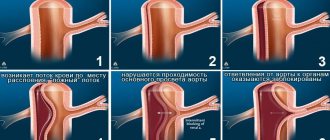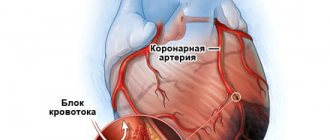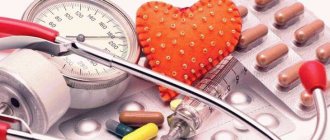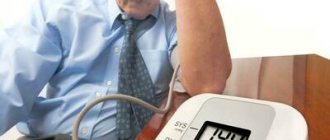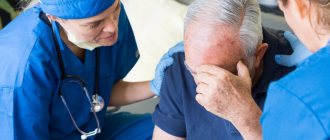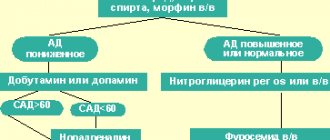In medical practice, the following types of hypertensive crises occur:
- uncomplicated is more common, the symptoms of which are leveled by taking medications;
- the complicated type causes disruption of the functioning of human internal organs.
A hypertensive crisis is dangerous due to complications - it can provoke pulmonary edema, acute heart failure, stroke or encephalopathy. The occurrence of dissecting aortic aneurysm is also noted. That is why, when symptoms appear, it is necessary to begin treatment promptly.
RELIEF OF HYPERTENSION CRISIS
A hypertensive crisis is a sudden increase in blood pressure, as a result of which a person’s well-being sharply worsens. It is very difficult to predict the development of the crisis. For each individual patient, a hypertensive crisis is characterized by an increased level of blood pressure, which differs from the regular one.
How dangerous is a hypertensive crisis?
A hypertensive crisis is dangerous because it causes serious complications - vital organs are affected: the liver, kidneys, heart and brain. In addition, a hypertensive crisis can lead to visual impairment. Therefore, when symptoms of a crisis appear, it is important to provide timely and quality assistance. It is to eliminate symptoms and prevent complications from occurring.
The causes of this condition in humans are:
- stress or emotional tension;
- changes in weather conditions: sudden cooling, warming, winds;
- alcohol poisoning;
- eating a lot of salt;
- discontinuation of therapy in those who have been taking antihypertensive drugs for a long time.
However, the most common cause is still nervous tension. Among the main manifestations of a hypertensive crisis is a feeling of fear and anxiety, which must be eliminated first in order for the pressure to return to normal.
Symptoms of a hypertensive crisis are:
- A sharp increase in blood pressure.
- Headache, which is localized in the back of the head, and dizziness;
- Nausea turning into vomiting - this symptom is more characteristic of a complicated hypertensive crisis;
- Vision problems - some patients complain of the appearance of dots in front of the eyes, partial blindness is possible;
- Redness of the skin in the face and neck;
- Trembling throughout the body;
- Feelings of fear and panic are common symptoms of a hypertensive crisis, as it is often caused by emotional tension or stress.
What to do for emergency care during a hypertensive crisis:
- First of all, it is necessary to calm the patient. You can take Corvalol, tincture of valerian or motherwort.
- Provide a flow of fresh air into the room where the patient is located by opening a window or vent.
- It is advisable to put the patient to bed, giving him a semi-sitting position with the help of pillows, to warm him up and ensure peace. Place an ice pack on your head
- or a cold compress, and put mustard plasters on the calves or the back of the head, or apply warm heating pads to the feet and legs (for 15-20 minutes).
- If chest pain and shortness of breath occur, take 1 tablet of nitroglycerin and call an ambulance.
- If signs of a hypertensive crisis appear, you can take ½ tablet of captopril (meaning a dosage of 25 mg) or 10 mg of nifedipine sublingually (under the tongue). If the expected effect after taking these drugs in the indicated dosage does not occur after half an hour, then you can take another same dose, but no more! If there is no effect after another 30 minutes, you must call an ambulance.
Hypertension
You are experiencing increased blood pressure. Arterial hypertension is a syndrome of increased blood pressure (BP) in hypertension and symptomatic arterial hypertension .
Depending on the etiology, arterial hypertension is divided into two groups:
1. Primary (hypertension).
2. Secondary (symptomatic arterial hypertension).
Hypertonic disease
– a chronic disease of the cardiovascular system, the leading manifestation of which is the syndrome of high blood pressure in the absence of a connection with diseases that cause symptomatic arterial hypertension.
Secondary (symptomatic) arterial hypertension
– increased blood pressure levels due to the manifestation of a specific disease (kidney disease, thyroid disease, pheochromocytoma, etc.).
Important to remember
that high blood pressure does not return to normal on its own and without treatment, high blood pressure leads to serious complications such as stroke and myocardial infarction. Currently, blood pressure levels can be successfully controlled using non-drug and medicinal means. If you are diagnosed with high blood pressure, it is important to immediately understand that a large proportion of successful treatment depends not only on the doctor and medications, but also on your own attitude towards the disease and strict adherence to recommendations. Increased blood pressure is caused by a number of factors closely related to lifestyle and habits: unhealthy diet, smoking, lack of physical activity, psycho-emotional stress, etc. As a result of medical monitoring, specific risk factors for increased blood pressure are clarified, as well as the risk of complications and the need to fully follow the prescribed recommendations .
The main areas of prevention that help normalize blood pressure levels:
1. Regular self-monitoring of blood pressure levels by patients.
2. Non-drug methods of prevention.
3. Antihypertensive therapy, which is prescribed and adjusted only by a doctor.
- Self-monitoring of blood pressure levels by patients
To assess the effectiveness of preventive and therapeutic measures, self-measurement of blood pressure levels by the patient at home is of great importance. The reliability of blood pressure self-monitoring results depends on patient training in the correct measurement technique and the use of devices that meet international accuracy standards.
Regular self-monitoring of blood pressure levels promotes the patient's active participation in controlled treatment of hypertension, increases his adherence to preventive measures and therapy, and expands awareness of his health status.
Blood pressure levels should be measured twice a day - morning and evening - in a sitting position after resting for 5 minutes. The morning measurement is carried out within an hour after waking up (before breakfast), the evening measurement - before dinner or at least 2 hours after dinner.
In patients with frequently recurring hypertensive crises, in addition to routine measurements, additional monitoring of blood pressure levels is necessary during periods of deterioration in health. Such episodes, as well as the results of routine measurements, should be recorded by the patient in a diary.
2. Non-drug prevention methods that help normalize blood pressure
2.1.Smoking cessation. Under the influence of nicotine, the heart rate increases, vasospasm occurs, and as a result, blood pressure increases, which significantly increases the risk of cardiovascular complications (stroke, myocardial infarction, etc.).
2.2. Reducing table salt consumption. You should limit your consumption of table salt as much as possible - to 5 grams per day or less. Salt retains fluid in the body and weakens the effectiveness of all antihypertensive drugs.
2.3.Reduction of excess body weight.
Weight loss is accompanied by a decrease in both systolic and diastolic blood pressure levels.
2.4. Increase physical activity.
Increased physical activity has a positive effect on blood pressure levels.
Even a little physical activity is better than no physical activity at all. Fast walking, aerobic exercise, and swimming, when performed regularly, can reduce high blood pressure.
For this purpose, 3-4 classes per week at an energetic pace for 30-45 minutes are enough. 2.5. Reduce or stop drinking alcohol.
You need to limit, and if possible completely stop, alcohol consumption. Alcohol causes an increase in blood pressure both during chronic use and during withdrawal syndrome, which is a risk factor for the development of complications of the disease.
2.6. Comprehensive diet modification.
A healthy diet based on increasing the consumption of vegetables and fruits, including fish and seafood, as well as limiting animal fats, helps lower blood pressure levels and reduce the risk of cardiovascular complications.
2.7. Elimination of psycho-emotional stress.
Psychoemotional stress, which is typical for most patients with arterial hypertension, plays an important role in increasing blood pressure levels. In the conditions of the intense rhythm of modern life, reduction and, if possible, complete elimination of psycho-emotional stress on the basis of adequate psychological support, becomes an essential element in the prevention of hypertension and hypertensive crises.
Antihypertensive therapy
If the effect of non-drug methods of normalizing blood pressure is insufficient, drug antihypertensive therapy is indicated. With the help of your doctor, you need to select medications to maintain normal blood pressure levels and constantly take them in recommended doses. Remember that hypertension cannot be cured, so you cannot take breaks from taking medications or take them in “courses”!
The most important requirement for normalizing high blood pressure is regularly visiting your doctor. Most cases of hypertensive crises and cardiovascular complications develop against the background of unauthorized withdrawal of antihypertensive drugs. Medicines recommended by your doctor to normalize blood pressure should always be with you!
In some cases, an acute increase in blood pressure takes on a crisis course - a hypertensive crisis.
Hypertensive crisis -
This is a sudden, sharp rise in blood pressure, accompanied by a deterioration in health and the development of complications.
Unlike arterial hypertension, during a hypertensive crisis there is a sudden (from several minutes to several hours) increase in blood pressure, to individually high values, accompanied by clinical symptoms, requiring an immediate, controlled decrease in blood pressure to prevent damage to vital organs (heart, brain, kidneys).
The main symptoms of a hypertensive crisis:
● headaches of various types, dizziness, nausea, vomiting;
● blurred vision in the form of a veil or flickering “flies” before the eyes;
● heaviness or pain in the heart area;
● feeling of shortness of breath, chills, trembling, sweating, etc.
You must call an ambulance and do the following before it arrives:
● place the patient in a bed or chair so that the head is elevated;
● unbutton the collar and remove clothing that restricts the chest;
● open the window for fresh air;
● measure blood pressure.
You need to remember that you cannot sharply lower your blood pressure on your own! Relieving a hypertensive crisis involves a gradual decrease in pressure, otherwise organ ischemia may develop.
Further actions are determined by the emergency medical personnel!
Hypertensive crisis - what is it and first aid
Increased blood pressure (Arterial hypertension or hypertension) is one of the most common and dangerous diseases of the cardiovascular system of our body. According to statistics, one third of the entire adult population of Russia suffers from high blood pressure. This disease requires special treatment and constant monitoring. Otherwise, there is a risk of developing complications, one of which is hypertensive crisis (HC).
A hypertensive crisis is an emergency condition that occurs due to a sharp increase in blood pressure. Contrary to public opinion, a hypertensive crisis does not have characteristic blood pressure numbers; these indicators are very individual. For some it is 160/100 mmHg. Art. - “usual numbers”, and for the other - 140/90 mm. Hg Art. - a severe crisis! A hypertensive crisis is always accompanied by a significant deterioration in well-being and requires a reduction in blood pressure!
Most often, against the background of a sharp rise in blood pressure, the following may bother you:
- headache, dizziness, feeling of pulsation in the head;
- nausea, vomiting;
- heart pain, palpitations;
- nose bleed;
- chills or sweating;
- flickering of “flies” before the eyes, partial loss of visual fields is possible;
- shortness of breath or suffocation;
- redness of the skin;
- excitement or weakness, irritability.
Reasons for the development of hypertensive crisis:
- stopping taking antihypertensive drugs;
- psycho-emotional stress, anxiety states;
- weather changes (weather dependence);
- excess salt and fluid intake;
- excessive physical activity;
- alcohol abuse;
- taking hormonal contraceptives;
- taking drugs;
- surgery, pain
- sleep apnea syndrome;
- temperature increase.
First aid for hypertensive crisis:
If you suspect a hypertensive crisis, immediately call an ambulance, remember that the process develops quickly. Before the team of doctors arrive, help the patient lie down or sit comfortably: give him a comfortable semi-lying position, placing pillows, a folded blanket, etc. under his shoulders and head. This will help avoid severe attacks of suffocation. Make sure there is access to fresh air - open a window, unfasten tight-fitting clothes.
Before the doctor arrives, you need to monitor the patient’s blood pressure and give a pill to lower it (the drug that he uses constantly or captopril (captopril) under the tongue). It is impossible to sharply reduce blood pressure during a hypertensive crisis (collapse may occur). To stop the crisis, it is necessary that the pressure decrease by no more than 30 mm within an hour. Hg Art. compared to the original one. It is important to know that at the time of a hypertensive crisis, patients often experience a strong feeling of fear. This is due to a sharp release of stress hormones. And your task is not to show, through your actions or words, unnecessary concern about his condition, not to panic. Talk calmly, kindly, reassuring the patient and telling him that this condition will pass, and the doctor will certainly help. Remember that the outcome of the disease largely depends on your first actions.
Further appointments should only be made by a doctor. After a hypertensive crisis, consultation with a cardiologist is necessary. It is imperative to undergo a comprehensive examination of the cardiovascular system, this is the only way to avoid a recurrence of a hypertensive crisis and its terrible consequences - stroke, heart attack, angina pectoris, loss of vision, dysfunction of the kidneys and other internal organs.
Against the background of a hypertensive crisis, the following may develop:
- transient ischemic attack (TIA);
- stroke;
- myocardial infarction, angina pectoris, pulmonary edema;
- dissecting aortic aneurysm.
Important!
During a hypertensive crisis, double or triple doses of medications should not be taken simultaneously. A repeat tablet can be taken no earlier than 30 minutes after taking the first one. This can provoke a rapid drop in blood pressure and cause loss of consciousness and stroke!
Remember!
If, against the background of a crisis, the patient develops speech impairment, facial asymmetry, confusion or loss of consciousness, convulsions, weakness in an arm or leg, suffocation, severe pain in the chest or abdomen - do not self-medicate, call an ambulance immediately!
All advice on taking various antihypertensive drugs from relatives, friends, neighbors, or the pharmacist at the pharmacy can harm your health!
Link to video “What is hypertension”:
Healthcare of Mogilev
Risk factors for developing arterial hypertension:
- men over 55 years old,
- women over 65 years old, men over 55 years old
- smoking, drinking alcohol
- cholesterol level (CH) more than 6.5 mmol/l,
- family history of early CVD (women under 65 years of age, men under 55 years of age).
- excess salt intake
- physical inactivity
- stress
- obesity
Method of measuring blood pressure:
- after a 5-minute rest, avoid eating, caffeine (tea, coffee) or smoking (if the patient smokes) for half an hour; after active physical or emotional stress, blood pressure can be measured no earlier than half an hour later;
- in a sitting position, in a comfortable position: the arm is placed freely on the table, supported by the back of the chair, the legs are relaxed and do not cross;
- exclude conversation while measuring blood pressure;
- in the presence of stable asymmetry in both arms (SBP/DBP >10/5 mm Hg), measurements should be taken on the arm with higher blood pressure numbers; in the absence of asymmetry, measurements should be taken on the non-working arm;
- air injection into the cuff should be fast, release should be slow (2 mm Hg per 1 second);
- You should perform at least 2 measurements with an interval of 1-2 minutes and evaluate the average value of the measurements obtained;
- use standard cuffs of three appropriate sizes, and the cuff must cover at least 80% of the patient’s shoulder circumference;
- the middle of the cuff should be located at the level of the heart (approximately at the level of the 4th intercostal space), the cuff should not be placed on the fabric of clothing, a distance the size of a finger should remain between the cuff and the surface of the shoulder, its lower edge should be 2 cm above the ulnar fossa;
- A record of the obtained blood pressure values should be made with an accuracy of 2 mm Hg. Art.
The most common errors leading to incorrect blood pressure measurements:
- using a cuff that does not fit the shoulder;
- little time for the patient to adapt to the conditions of the doctor’s office;
- high rate of pressure reduction in the cuff;
- lack of asymmetry control
The measurement should be carried out for 7 days - 2 times a day, morning and evening. Measurements should be taken before eating and taking antihypertensive medications. At least 2 measurements should be taken with an interval of 1-2 minutes and the average value of the obtained measurements should be assessed. The average value of blood pressure and heart rate is recorded by the patient in a diary, unless a memory function is provided in the device. It is not recommended to include the measurement results on the first day in subsequent medical analysis. An increase in blood pressure measured at home is diagnosed at a level above 135/85 mm Hg. Art. The blood pressure self-monitoring method can be used initially to select antihypertensive treatment and 7 days before a subsequent visit to the doctor to assess the effectiveness of the prescribed therapy.
Blood pressure level classification:
| Blood pressure categories | GARDEN | DBP |
| Optimal blood pressure | < 120 | < 80 |
| Normal blood pressure | 120-129 | 80-84 |
| High normal blood pressure | 130-139 | 85-89 |
| AG 1st | 140-159 | 90-99 |
| AG 2st | 160-179 | 100-109 |
| AG 3st | ≥180 | ≥110 |
| Isolated systolic blood pressure | ≥140 | <90 |
Principles of treatment of arterial hypertension
The goal of treating a patient with arterial hypertension is to maximally reduce the overall risk of cardiovascular morbidity and death, which involves not only lowering blood pressure, but also correcting identified risk factors.
Principles of non-drug treatment of arterial hypertension Non-drug measures are aimed at lowering blood pressure, reducing the need for antihypertensive drugs and enhancing their effect, primary prevention of arterial hypertension and associated cardiovascular diseases at the population level.
A non-pharmacological BP lowering program should be recommended to all patients, regardless of the severity of hypertension and drug treatment.
It includes:
- smoking cessation;
- reduction of excess body weight;
- reducing the consumption of table salt;
- reducing alcohol consumption;
- comprehensive diet modification;
- increase in physical activity.
Drug therapy should be started according to the recommendations of the attending physician.
When drug therapy is discontinued on its own, blood pressure may increase, leading to hypertensive crises. A hypertensive crisis can also be triggered by:
- excessive consumption of salt and water;
- self-cancellation of medications;
- meteorological influence (the predominant number of crises occur in the spring and autumn months with a sharp temperature change, heat and extreme cold);
- stress
- colds, kidney and bladder diseases. If you do not take certain measures to prevent the disease, it can provoke a crisis.
- emotional or physical overload;
- weather changes, meteorological changes (“magnetic storms”);
- smoking;
- consumption of alcoholic beverages;
- large meals, especially at night;
- consumption of food or drinks containing substances that increase blood pressure (coffee, chocolate, cheese, caviar, etc.).
A hypertensive crisis is a sudden, sharp rise in blood pressure, accompanied by a deterioration in health and the development of complications.
Signs of a hypertensive crisis
| Symptom | Availability |
| Sharp headache in the back of the head | |
| Diffuse headache without clear localization | |
| Noise in the ears, head | |
| Nausea, vomiting | |
| Deterioration of vision: fog, grid, veil, floaters before the eyes | |
| Dyspnea | |
| Heaviness, pain in the heart area | |
| Anxiety, fear | |
| Trembling in the hands, throughout the body | |
| Dry mouth | |
| Facial hyperemia | |
| Frequent urination | |
| Depression, drowsiness | |
| Swelling of the face and fingers | |
| Palpitations, irregularities in the heart area | |
| Numbness of tongue, lips, face | |
| Goose bumps all over your body | |
| Loss of consciousness | |
| Symptoms that you have but are not reflected in the table |
The duration of the crisis varies: from several hours to several days. It is important not to get confused.
The rules of behavior and the implementation of first aid during a hypertensive crisis must be learned by all patients with arterial hypertension; moreover, their relatives should also know these rules in order to come to the rescue and provide first aid in difficult times.
Rules of behavior and self-help for patients with arterial hypertension during crises and complications:
Rule 1. If you suffer from hypertension, then you must always be prepared for the fact that your blood pressure may periodically increase.
Rule 2. Consult with a doctor how to reduce blood pressure at home, what medications to take in this case before the ambulance arrives.
Rule 3. Do not escalate the situation, because panic and fear lead to an even greater increase in pressure.
Self-help for hypertensive crisis at home:
- Stop physical activity.
- Sit or lie down with your head elevated, measure your blood pressure; You need to calm down and not panic. You can take valerian, motherwort.
- Restore your breathing - take a few deep breaths and exhales.
- When experiencing a hypertensive crisis for the first time in your life, be sure to call an ambulance. For the ambulance dispatcher, clearly formulate your complaints and give your blood pressure number.
- In case of repeated hypertensive crises, emergency care should be provided taking into account the existing experience in treating previous GCs.
- Regardless of the type of HA, you should use medications recommended by your attending physician as self-help.—
- Monitor the decrease in blood pressure after 30 minutes. A good effect is a reduction in blood pressure by 20-25%. from the initial blood pressure within 2 hours.
- If the expected effect is not achieved, you can repeat the medication.
- Control of blood pressure reduction should also be carried out after 30 minutes. If such a reduction in blood pressure has been achieved, then additional doses of blood pressure-lowering medications should not be taken. It is necessary to contact your local general practitioner (call a doctor at home or attend an appointment at the clinic) to correct antihypertensive therapy.
- If the blood pressure level does not decrease or, on the contrary, continues to increase, it is recommended to call an ambulance.
ATTENTION! It is imperative to call an ambulance in the following cases:
- first-time hypertensive crisis;
- the appearance of chest pain, severe shortness of breath, dizziness, weakness, interruptions in heart function, impaired movement of the limbs;
- lack of effect from the drug therapy.
St. Petersburg State Budgetary Healthcare Institution "City Clinic No. 114"
Hypertensive crisis (Hc) is a condition manifested by high blood pressure (systolic “upper” blood pressure, usually more than 180 mm Hg; diastolic “lower” blood pressure - more than 120 mm Hg) and the following symptoms: - headache, often in the occipital region, or heaviness and noise in the head; - flashing “flies”, a veil or a net before the eyes; - nausea, feeling of exhaustion, overwork, internal tension; - shortness of breath, weakness, constant monotonous aching pain/discomfort in the heart area; - the appearance or increase in pastosity/swelling of the skin of the face, arms, legs.
First aid measures: When symptoms of a hypertensive crisis appear, it is necessary to: - remove bright light, ensure peace, access to fresh air (unbutton the shirt collar, ventilate the room, etc.); - measure blood pressure (see the method for measuring blood pressure at the end of this section) and, if its “upper” level is higher than or equal to 160 mm Hg. Art., you must take an antihypertensive drug previously recommended by your doctor. In the absence of a doctor-recommended antihypertensive drug or when a blood pressure level is recorded above 200 mm Hg. Art. urgently need to call an ambulance. Before emergency medical services arrive, you should, if possible, sit in a chair with armrests and take a hot foot bath (put your feet in a container of hot water). Attention: A patient with a hypertensive crisis is prohibited from any sudden movements (suddenly getting up, sitting down, lying down, bending over, pushing) and any physical activity. After 40 - 60 minutes. after taking the medicine recommended by the doctor, it is necessary to re-measure blood pressure and if its level has not decreased by 20 - 30 mm Hg. Art. from the initial state and/or the condition has not improved - urgently call an ambulance. If you feel better and your blood pressure decreases, you need to rest (go to bed with the head of the bed raised) and then contact your local (family) doctor. When talking with your doctor, you need to clarify what medications you need to take if you develop a hypertensive crisis, clearly write down their names, dosage and time sequence (algorithm) for taking them, and also check with your doctor for what manifestations of the disease you need to urgently call an ambulance. All patients with hypertension need to create an individual mini-first aid kit for a hypertensive crisis and carry it with them at all times, since a hypertensive crisis can develop at any time and anywhere.
Blood pressure measurement To diagnose a hypertensive crisis, it is necessary to measure blood pressure, which is performed manually using a stethoscope and a special inflatable cuff equipped with a bulb pump and a sphygmamanometer, as well as an automatic (semi-automatic) method using various models of tonometers specially designed for these purposes. . The accuracy of blood pressure measurement and, accordingly, the guarantee of correct diagnosis and severity of a hypertensive crisis depend on compliance with the rules for its measurement. The measurement should be taken while sitting (leaning on the back of a chair, with relaxed and uncrossed legs, the hand resting on the table, at heart level), in a calm environment, after a 5-minute rest. During the measurement, you should not actively move or talk. In special cases, blood pressure can be measured while lying down or standing. The cuff is placed on the shoulder, its lower edge 2 cm above the elbow. The size of the cuff must correspond to the size of the arm: the rubber inflated part of the cuff must cover at least 80% of the shoulder circumference; for adults, a cuff 12 - 13 cm wide and 30 - 35 cm long (average size) is used; It is necessary to have large and small cuffs available for fat and thin arms, respectively. Before starting the measurement, the mercury column or sphygmomanometer needle should be at the zero mark and in front of the researcher’s eyes. Technique for measuring blood pressure: - install the head of the phonendoscope in the cubital fossa above the brachial artery passing through it; - quickly pump air into the cuff to a pressure value of 20 - 30 mm Hg. Art. exceeding the normal level of “upper” systolic blood pressure for a given person (if the measurement is made for the first time, the pressure level in the cuff is usually raised to 160 mm Hg). If at this pressure level the pulsation of the vessel in the cubital fossa remains, then the pressure in the cuff continues to be increased to a level of 20 mm Hg. Art. exceeding the pressure level at which the pulsation of the artery in the cubital fossa disappeared); - open the air release valve from the cuff, located next to the bulb pump, and reduce the pressure in the cuff at a speed of approximately 2 - 3 mm Hg. Art. per second; — during the process of releasing air from the cuff, two parameters are simultaneously monitored:
1) the pressure level on the manometer scale and 2) the appearance of pulsation sounds (called Korotkoff sounds) of the artery in the cubital fossa. The pressure level at the moment of the appearance of pulsation sounds corresponds to the level of “upper” systolic blood pressure, and the pressure level at the moment of complete disappearance of arterial pulsation sounds corresponds to the “lower” diastolic blood pressure (in children, adolescents and young people immediately after physical activity, in pregnant women and in some cases In pathological conditions in adults, arterial pulsation sounds do not disappear, then the “lower” diastolic blood pressure should be determined by the moment of significant weakening of the sounds). - if the pulsation sounds of the artery in the ulnar fossa are very weak, then you should raise your hand and perform several squeezing movements with the hand, then repeat the measurement, but do not strongly compress the artery with the membrane of the phonendoscope; - when measuring blood pressure for yourself, the head of the phonendoscope is fixed above the ulnar fossa using a cuff.
For a reliable assessment of blood pressure, it is necessary to perform at least two blood pressure measurements on each arm with an interval of at least a minute (in the pauses between measurements, the cuff must be completely loosened); when a pressure difference of more than 5 mm Hg is detected. Art. make one additional measurement; The average of the last two measurements is taken as the final (recorded) value.
